Coho Salmon Recipe: How to Cook Perfect Fish Every Time
Picture this: you’re hosting a dinner party, and the centerpiece of your menu is a perfectly prepared coho salmon that leaves your guests speechless. The fish flakes effortlessly, revealing tender, succulent flesh that practically melts on the tongue. This isn’t just culinary luck – it’s the result of mastering a proven coho salmon recipe that transforms ordinary home cooking into extraordinary dining experiences.
Coho salmon represents the pinnacle of Pacific Northwest seafood, offering a distinctive flavor profile that bridges the gap between delicate and robust. Whether you’re exploring traditional preparations or venturing into specialized techniques like a smoked salmon brine recipe or adapting for a keto salmon recipe, understanding coho salmon’s unique characteristics unlocks unlimited culinary possibilities.
Your journey toward salmon mastery begins with recognizing that coho salmon’s firm texture and rich flavor respond beautifully to diverse cooking methods. From simple pan-searing to sophisticated variations like maple salmon recipe preparations, spicy salmon recipe adaptations, and even bourbon salmon recipe techniques, this comprehensive guide provides the foundation for consistent, professional-quality results.
Table of Contents
Essential Coho Salmon Recipe Fundamentals
Coho salmon, also known as silver salmon, occupies a special position in the salmon family hierarchy. This Pacific Northwest treasure offers the perfect balance of flavor intensity and texture that makes it incredibly versatile for home cooking. Understanding these fundamental characteristics transforms your approach to any salmon recipe you encounter.
The distinctive qualities that set coho salmon apart include its moderate oil content, which provides richness without overwhelming delicate palates. This characteristic makes coho exceptionally forgiving during cooking, maintaining moisture even when slightly overcooked. The fish’s firm texture holds up beautifully to various cooking methods, from gentle poaching to high-heat searing.
Seasonal availability plays a crucial role in coho salmon quality. Wild coho salmon reaches peak condition during late summer and early fall, typically from July through September. During this period, the fish contains optimal oil content and develops the complex flavors that make coho salmon legendary among culinary enthusiasts.
Quality assessment begins with visual inspection. Premium coho salmon displays vibrant color ranging from deep orange to bright red, with clear eyes and firm flesh that springs back when pressed. The skin should appear metallic silver with minimal blemishes, while the overall aroma remains fresh and oceanic rather than overly fishy.
Complete Coho Salmon Recipe Collection
Classic Pan-Seared Coho Salmon Recipe
The foundation of exceptional coho salmon preparation lies in mastering the classic pan-seared approach. This technique showcases the fish’s natural flavors while developing a beautiful golden crust that provides textural contrast to the tender interior.
Essential Ingredients Matrix
| Component | Quantity | Quality Standards | Purpose |
|---|---|---|---|
| Coho Salmon Fillets | 4 pieces (6 oz each) | Wild-caught, skin-on | Primary protein |
| Olive Oil | 2 tablespoons | Extra virgin, cold-pressed | Cooking medium |
| Butter | 2 tablespoons | Unsalted, European-style | Flavor enhancement |
| Lemon | 1 large | Fresh, room temperature | Acidity balance |
| Fresh Thyme | 4 sprigs | Organic, vibrant green | Aromatic complexity |
| Salt | 1 teaspoon | Kosher, fine grain | Seasoning foundation |
| Black Pepper | 1/2 teaspoon | Freshly cracked | Spice accent |
| Garlic | 3 cloves | Fresh, firm | Flavor depth |
Begin by removing the salmon from refrigeration 20 minutes before cooking, allowing it to reach room temperature for even cooking. Pat the fillets completely dry with paper towels, then season generously with salt and pepper on both sides. This initial preparation ensures proper seasoning penetration and optimal searing results.
Heat a stainless steel or cast-iron skillet over medium-high heat until it begins to smoke lightly. Add olive oil, swirling to coat the pan evenly. Place the salmon fillets skin-side up in the pan, listening for the satisfying sizzle that indicates proper temperature. Resist the urge to move the fish immediately – allow it to develop a golden crust for 4-5 minutes.
Flip the salmon carefully using a thin spatula, then add butter, crushed garlic, and thyme sprigs to the pan. Tilt the pan and baste the salmon with the aromatic butter mixture, creating layers of flavor while finishing the cooking process. The internal temperature should reach 145°F for optimal doneness.
Advanced Smoked Salmon Brine Recipe Application
Transforming your coho salmon recipe through smoking techniques requires understanding how brining affects the fish’s texture and flavor development. The smoked salmon brine recipe approach creates complex flavor layers while ensuring moisture retention throughout the smoking process.
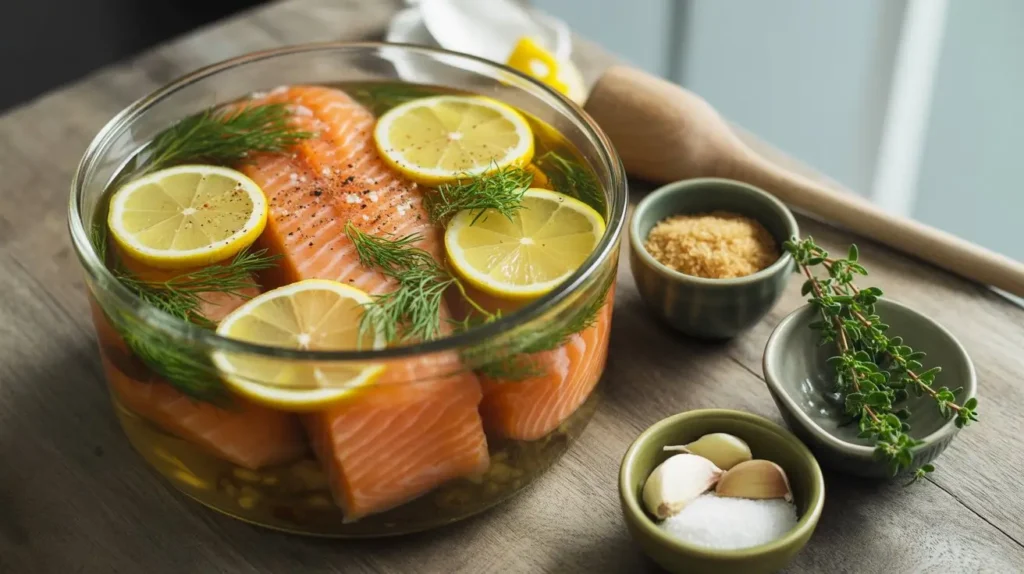
Create a base brine using 1 cup kosher salt, 1/2 cup brown sugar, and 8 cups water. Enhance this foundation with bay leaves, peppercorns, and fresh herbs that complement coho salmon’s natural flavors. The brining process typically requires 8-12 hours for optimal penetration, depending on fillet thickness.
After brining, rinse the salmon thoroughly and allow it to air-dry for 2-3 hours, developing a tacky surface called a pellicle. This step is crucial for proper smoke adhesion and flavor development. Smoke the salmon at 225°F using alder or apple wood chips, maintaining consistent temperature throughout the 3-4 hour process.
Keto Salmon Recipe Adaptation Strategies
Adapting your coho salmon recipe for ketogenic requirements focuses on maximizing healthy fats while eliminating carbohydrates. This keto salmon recipe approach enhances the fish’s natural oils while creating satisfying, macro-friendly meals.
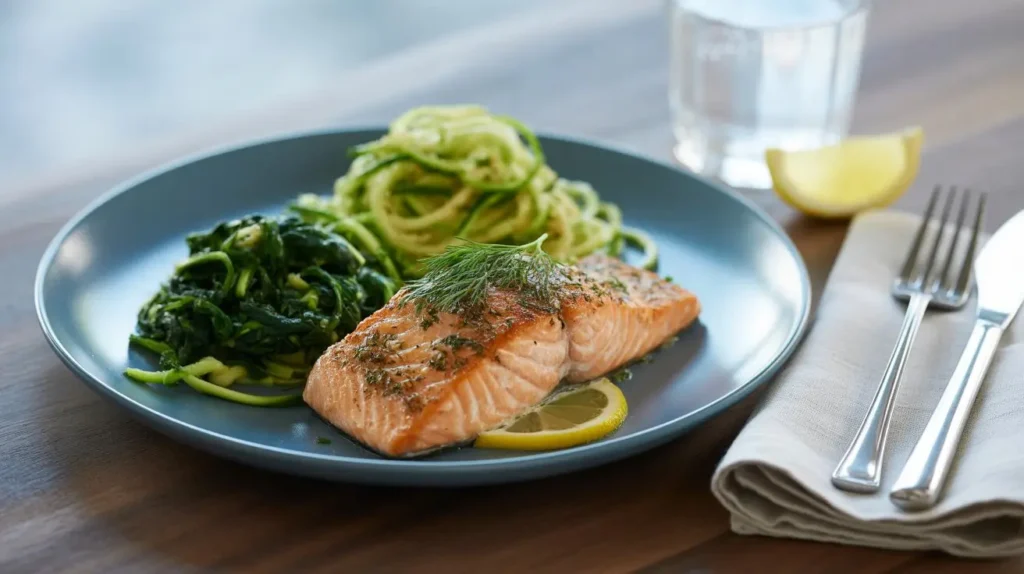
Replace traditional breadcrumb coatings with crushed pork rinds or almond flour alternatives. Increase butter and olive oil quantities to boost fat content, while incorporating avocado-based sides that complement the salmon’s richness. The result is a satisfying meal that supports ketogenic macronutrient goals without sacrificing flavor or presentation.
Herb-crusted preparations work exceptionally well for keto salmon recipe variations. Create a coating using fresh herbs, garlic, and olive oil that adheres beautifully to the fish while adding aromatic complexity. This technique provides textural interest while maintaining carbohydrate restrictions.
Maple Salmon Recipe Enhancement Techniques
The maple salmon recipe approach creates sophisticated flavor profiles by balancing the fish’s natural richness with maple syrup’s caramel notes. This technique requires careful attention to prevent overwhelming the salmon’s delicate flavors.
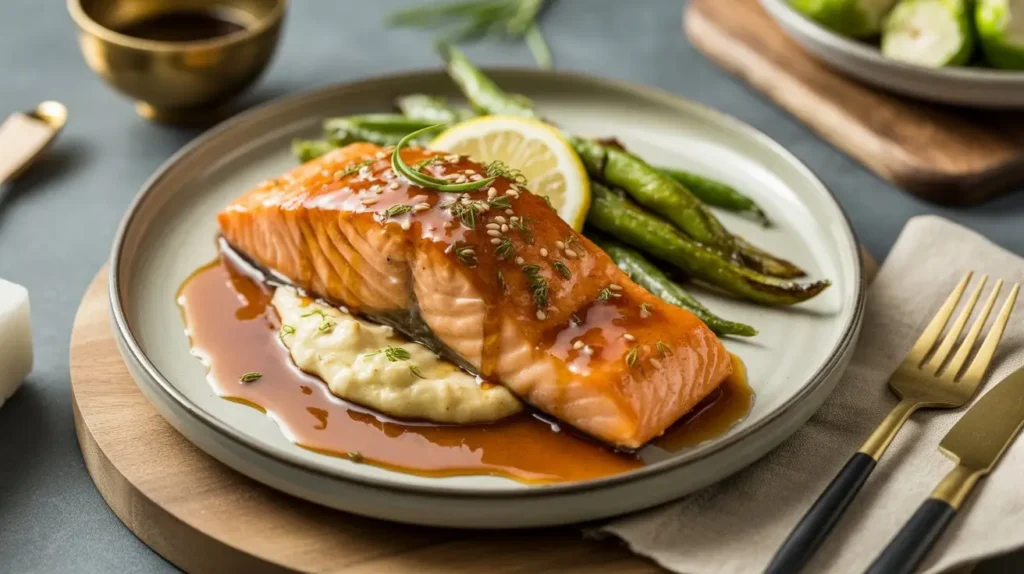
Begin with a glaze combining pure maple syrup, Dijon mustard, and soy sauce in equal proportions. Add minced garlic and fresh ginger for aromatic depth, then brush the mixture over the salmon during the final stages of cooking. The sugars in maple syrup caramelize beautifully, creating an attractive glaze that enhances both flavor and presentation.
Temperature control becomes crucial when working with maple-based preparations. The natural sugars can burn quickly, so maintain moderate heat and monitor the glazing process carefully. The result is a sophisticated dish that showcases both the salmon’s natural qualities and the maple’s distinctive sweetness.
Spicy Salmon Recipe Variations
Developing an exceptional spicy salmon recipe requires understanding how heat interacts with the fish’s oils and proteins. This approach creates dynamic flavor profiles that excite the palate while maintaining the salmon’s fundamental characteristics.
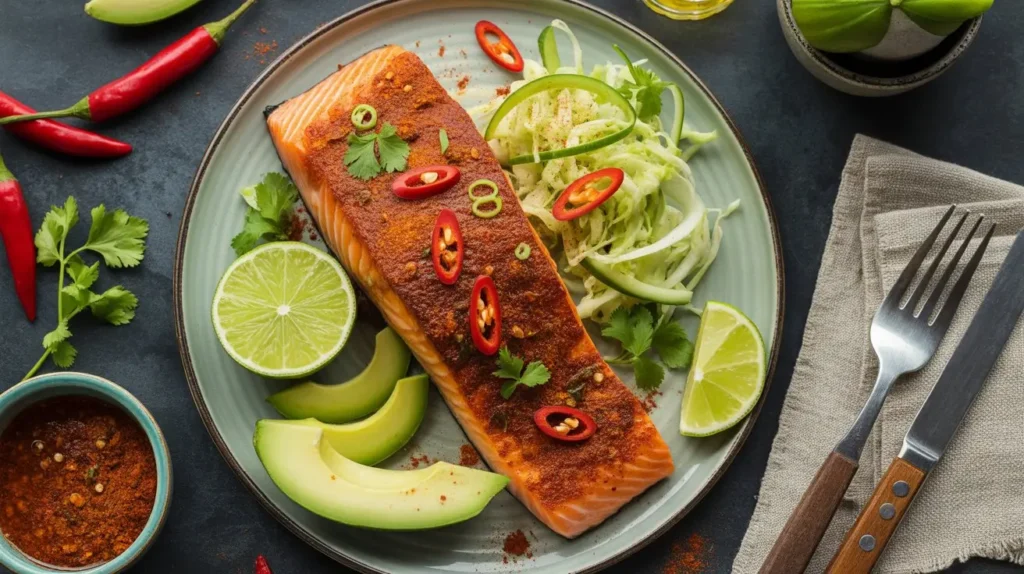
Create a spice paste using chipotle peppers, paprika, cayenne, and cumin. Combine these dry spices with olive oil and lime juice to form a marinade that penetrates the fish while adding layers of heat and complexity. The smoking process mellows harsh edges while concentrating flavors.
Balance the heat with cooling elements like yogurt-based sauces or fresh cucumber preparations. These accompaniments provide relief while allowing the spice flavors to shine. The contrast creates a more dynamic dining experience that showcases your culinary creativity.
Bourbon Salmon Recipe Sophistication
The bourbon salmon recipe represents the pinnacle of flavor sophistication, incorporating alcohol’s unique ability to extract and enhance natural flavors. This advanced technique requires understanding how alcohol interacts with fish proteins and cooking temperatures.
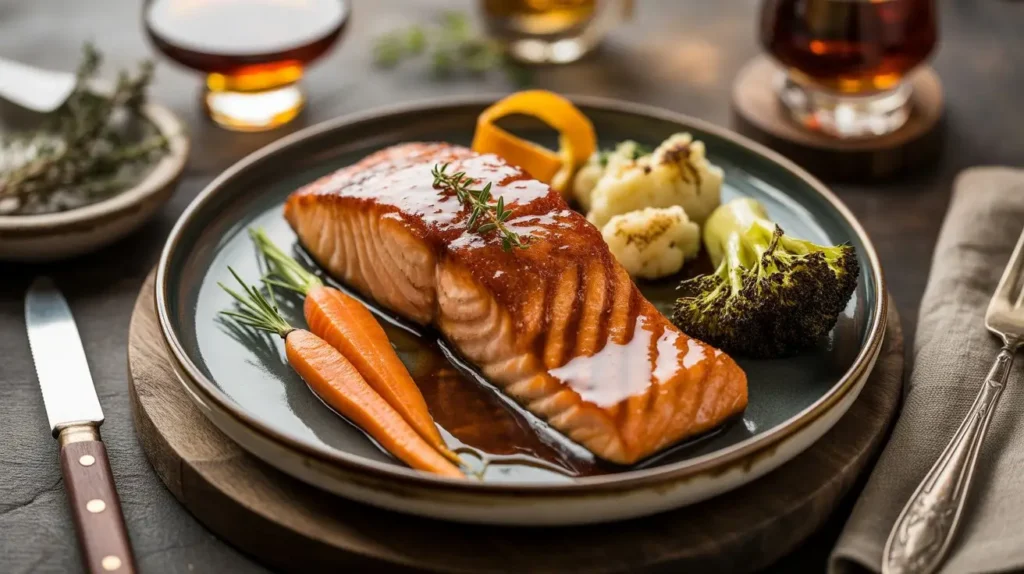
Create a bourbon glaze by reducing bourbon with brown sugar, soy sauce, and fresh herbs. The alcohol evaporates during cooking, leaving behind complex flavors that complement the salmon’s richness. Add the glaze during the final cooking stages to prevent burning while ensuring proper flavor development.
Select bourbons with complementary flavor profiles – wheated varieties provide smooth sweetness, while high-rye bourbons add spicy complexity. The choice significantly impacts the final dish’s character, allowing for creative expression within professional frameworks.
Advanced Cooking Methodology Framework
Cooking Techniques Comparison Matrix
| Method | Temperature | Time | Texture Result | Flavor Profile |
|---|---|---|---|---|
| Pan-Seared | Medium-High | 8-10 minutes | Crispy exterior, tender interior | Concentrated, caramelized |
| Baked | 400°F | 12-15 minutes | Uniform, flaky | Clean, pure salmon flavor |
| Grilled | Medium | 10-12 minutes | Smoky, firm | Charred complexity |
| Poached | 160°F | 15-20 minutes | Silky, delicate | Subtle, refined |
| Smoked | 225°F | 3-4 hours | Dense, concentrated | Deep, complex |
Understanding these fundamental cooking methods enables you to select the optimal technique for your specific goals and available equipment. Each method produces distinctly different results, allowing for creative menu planning and seasonal adaptation.
Temperature control remains the most critical factor in salmon preparation success. Investment in a reliable instant-read thermometer eliminates guesswork while ensuring consistent results. The target internal temperature of 145°F provides optimal food safety while maintaining the fish’s natural moisture and texture.
Professional Quality Assessment Protocols
Doneness Evaluation Techniques
Mastering doneness assessment transforms your coho salmon recipe results from acceptable to exceptional. Visual cues include the flesh changing from translucent to opaque, with gentle flaking when pressed with a fork. The internal temperature should reach 145°F throughout the thickest portion.
Texture evaluation involves pressing the salmon gently with your finger. Properly cooked salmon feels firm yet yields slightly to pressure. Overcooked salmon becomes hard and dry, while undercooked fish feels mushy and translucent. These tactile cues develop through practice and experience.
Color changes provide additional doneness indicators. Raw salmon appears translucent with deep coloration, while cooked salmon becomes opaque with lighter, more uniform color throughout. The skin should separate easily from the flesh when properly cooked.
Troubleshooting Common Challenges
Overcooking represents the most frequent challenge in salmon preparation. Prevention strategies include removing the fish from heat slightly before reaching target temperature, allowing residual heat to complete the cooking process. This technique, known as carryover cooking, ensures optimal results.
Moisture retention requires attention to initial preparation and cooking technique. Proper seasoning timing, temperature control, and avoiding excessive manipulation during cooking all contribute to maintaining the salmon’s natural juices. Resting the cooked salmon for 2-3 minutes before serving allows juices to redistribute throughout the flesh.
Flavor development depends on proper seasoning timing and technique selection. Salt should be applied 20-30 minutes before cooking to allow proper penetration, while delicate herbs are best added during the final cooking stages to prevent burning and preserve their aromatic qualities.
Nutritional Optimization and Health Benefits
Comprehensive Nutritional Analysis
| Nutrient | Per 6oz Serving | Daily Value % | Health Benefits |
|---|---|---|---|
| Protein | 42g | 84% | Muscle maintenance, satiety |
| Omega-3 Fatty Acids | 2.8g | 175% | Heart health, inflammation reduction |
| Vitamin D | 450 IU | 113% | Bone health, immune function |
| Vitamin B12 | 4.8mcg | 200% | Energy metabolism, nerve function |
| Selenium | 38mcg | 69% | Antioxidant activity, thyroid function |
| Potassium | 620mg | 18% | Blood pressure regulation |
Coho salmon’s exceptional nutritional profile makes it an ideal choice for health-conscious cooking. The high-quality protein content supports muscle maintenance and metabolic function, while the omega-3 fatty acids provide cardiovascular and cognitive benefits that extend far beyond basic nutrition.
The vitamin D content in coho salmon significantly contributes to bone health and immune function, particularly important during winter months when natural vitamin D synthesis is limited. This makes your coho salmon recipe not just delicious but nutritionally strategic for optimal health maintenance.
Selenium acts as a powerful antioxidant, protecting cells from oxidative damage while supporting thyroid function. The combination of selenium with omega-3 fatty acids creates synergistic health benefits that make regular salmon consumption a smart dietary choice.
Storage and Preservation Mastery
Proper storage begins with understanding salmon’s perishable nature and implementing protocols that maintain quality while ensuring food safety. Fresh coho salmon should be stored at 32-38°F and used within 1-2 days of purchase for optimal flavor and texture.
Freezing techniques require careful attention to prevent texture degradation. Wrap individual portions tightly in plastic wrap, then place in freezer bags with air removed. Properly frozen salmon maintains quality for up to 6 months, though fresher is always better for optimal results.
Leftover cooked salmon transforms beautifully into salmon salads, pasta dishes, or breakfast preparations. Store cooked salmon in the refrigerator for up to 3 days, maintaining proper temperature control to prevent bacterial growth while preserving the fish’s quality characteristics.
Strategic FAQ Section
What makes coho salmon recipe preparation unique compared to other salmon varieties?
Coho salmon’s moderate oil content and firm texture make it exceptionally versatile for various cooking methods. Unlike Atlantic salmon, which can be very fatty, or sockeye salmon, which can be lean, coho provides the perfect balance for consistent cooking results across different techniques.
How do I adapt a coho salmon recipe for keto diet requirements?
Transform any coho salmon recipe into a keto salmon recipe by eliminating carbohydrate-containing ingredients and increasing healthy fats. Replace breadcrumbs with crushed pork rinds, skip sugary glazes, and increase butter or olive oil quantities to meet ketogenic macronutrient requirements.
Can I use a smoked salmon brine recipe for coho salmon specifically?
Yes, coho salmon responds exceptionally well to brining techniques. Use the smoked salmon brine recipe approach with 8-12 hour brining times for optimal flavor penetration. Coho’s firm texture holds up beautifully to the brining process while developing complex flavor layers.
What’s the best maple salmon recipe approach for coho salmon?
Create a maple salmon recipe by combining pure maple syrup with Dijon mustard and soy sauce for a balanced glaze. Apply during the final cooking stages to prevent burning while allowing the natural sugars to caramelize, creating an attractive finish that enhances the coho’s natural flavors.
How do I create a spicy salmon recipe using coho salmon?
Develop a spicy salmon recipe by creating a paste with chipotle peppers, paprika, and cayenne mixed with olive oil and lime juice. The marinade penetrates coho’s firm texture while adding heat layers that complement rather than overwhelm the fish’s natural richness.
Can I incorporate bourbon into my coho salmon recipe?
Create a sophisticated bourbon salmon recipe by reducing bourbon with brown sugar and soy sauce to form a glaze. The alcohol evaporates during cooking, leaving complex flavors that enhance the coho’s natural characteristics while adding professional-level sophistication.
What cooking temperature ensures perfect coho salmon every time?
Target an internal temperature of 145°F for optimal coho salmon results. This temperature ensures food safety while maintaining the fish’s natural moisture and texture. Use an instant-read thermometer for accurate measurement and consistent results.
How long should I cook coho salmon for best results?
Cooking time depends on thickness and method. Pan-seared coho salmon typically requires 4-5 minutes per side for 1-inch thick fillets. Baked coho salmon needs 12-15 minutes at 400°F. Always use temperature rather than time as your primary doneness indicator.
Mastering Your Culinary Excellence Journey
Your mastery of the perfect coho salmon recipe represents more than technical skill – it demonstrates your commitment to culinary excellence and your ability to transform premium ingredients into memorable dining experiences. Whether you’re implementing classic techniques or exploring advanced variations like keto salmon recipe adaptations, maple salmon recipe enhancements, or sophisticated bourbon salmon recipe preparations, success depends on understanding fundamental principles while embracing creative expression.
The comprehensive methodologies outlined here provide the foundation for consistent, professional-quality results that will impress family and guests alike. From specialized smoked salmon brine recipe applications to dynamic spicy salmon recipe variations, each technique builds upon core principles while offering unique flavor profiles and presentation opportunities.
Remember that culinary mastery develops through consistent practice, thoughtful experimentation, and attention to detail. Each successful preparation builds confidence while expanding your repertoire of techniques and flavor combinations. The journey toward becoming a salmon preparation expert requires patience, but the rewards – both in terms of personal satisfaction and the joy you bring to others through exceptional food – make the effort worthwhile.
Your commitment to excellence in salmon preparation positions you as a serious home cook who understands that great food begins with great ingredients and is perfected through proper technique. Continue exploring, experimenting, and refining your approach while maintaining the fundamental principles that ensure consistent success.
Transform Your Kitchen into a Culinary Destination:
- Source premium coho salmon from trusted suppliers who understand quality standards
- Master fundamental techniques before advancing to specialized preparations
- Invest in quality equipment that supports consistent temperature control and timing
- Document your successes and variations for continuous improvement
- Share your culinary creations with others who appreciate exceptional food
- Continue learning through practice, experimentation, and connection with fellow cooking enthusiasts
The difference between ordinary and extraordinary coho salmon preparation lies in the details, techniques, and commitment to excellence you now possess. Your kitchen awaits transformation into a destination for memorable dining experiences that celebrate the exceptional flavors and nutritional benefits of perfectly prepared coho salmon.
Tried This Recipe? Tell Us How It Went!
There are no reviews yet. Be the first one to write one.

